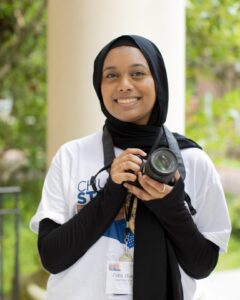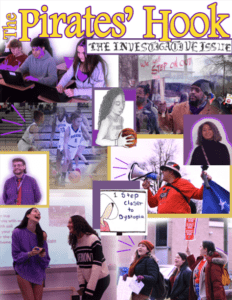By Catherine Komp,
Newsletter Editor
Zeba Hussaini’s first year of high school was during the pandemic. And like a lot of us, she found the experience challenging.
“I didn’t go out. I couldn’t really do the stuff I really wanted to do. I was kind of isolated,” said Hussaini.
When in-person classes returned her sophomore year, Hussaini wanted to find something at school she could immerse herself in. Scrolling through Instagram, she saw a post from the Green Hope Falcon, the student-run news organization for Green Hope High School in Cary. She was intrigued.
“I didn’t really have any prior experience in terms of writing and editing, but after being in a year of isolation, that’s how I got the jumpstart into journalism,” Hussaini told NC Local.

The year-long Leadership in Media class gave Hussaini that connection and collaboration she craved while also opening up opportunities to pursue stories important to her peers and the larger community. She covered students’ experiences during Ramadan and reactions to the confirmation of US Supreme Court Justice Ketanji Brown Jackson; local charitable responses to the 2023 earthquake in Turkey and Syria; and co-reported a story on colorectal cancer that focused on data, prevention and the impact on caregivers.
This past year, Hussaini served as editor-in-chief of the nearly 30-person newsroom and helped the team reach a coveted goal: earning “Distinguished Site” recognition in six categories by School News Online (SNO), the publishing platform for scholastic journalism.
It’s easy to see why the Green Hope Falcon is attracting accolades. Students are tackling in-depth stories, like a recent article by Alan Shr and Peggy Chen on the rise of construction worker deaths in work zone crashes. The piece explored a recent North Carolina work zone fatality, the impact of work zones on students and other pedestrians, and advocates’ work to implement solutions. The story also included an original illustration, photography and an infographic.
“We try to not only cover campus life, but we also want to cover stuff that’s relevant to the local community,” said Hussaini. “We know people outside of Green Hope click on those links and we want to make sure we’re providing the most accurate and the most relevant stories that not only resonate with our students, but that also resonate with Cary and Raleigh and whoever lives in the area.”
Hussaini, who was a 2023 Chuck Stone scholar, graduates this week and is off to Meredith College to study computer science and pre-med. But she says she’ll take her journalism experiences with her.
“Aside from the writing and editing, I’ve also learned to have a little bit more empathy, have a little bit more understanding when you’re interviewing someone,” said Hussaini. “I got to learn so much about people’s individual stories and what makes them who they are. So that was incredibly rewarding and I feel like this class has taught me so many lessons and I will definitely carry that with me through college and beyond.”
Behind the scenes, advisers motivate and inspire
Hussaini and other students at Green Hope High praise the role of their adviser, Matthew Mayse (also an English teacher and Wake County teacher of the year semi-finalist), who they credit with helping save the school’s journalism initiative a few years ago.
“Under your leadership, Green Hope’s journalism program has truly flourished,” wrote former Editor-in-Chief Lucas Moore in a special tribute to Mayse from the editors last year. “You have taken us from a little-read Google Site to a nationally ranked journalism program, and I’m incredibly thankful for the care, energy, and excitement you bring to the class every day.

In nearby Durham, another impressive student-run publication is the bilingual Pirates’ Hook at Riverside High. Senior Business Manager and Staff Writer Jaden Butler says he was drawn to the journalism program after meeting the adviser, English teacher Bryan Christopher.
“I felt a connection and that I could freely be myself. And also when I started sophomore year, I was like, ‘I want him to be my teacher. I want him to help me get through high school,’” said Butler during a session at the 2024 NC News & Information Summit.
With Christopher’s mentorship, Butler built up new skills and sharpened existing ones, including developing his writing. Butler’s coverage includes this story looking at the people breaking gender barriers in high school sports including Brooklyn Harker, the first female to play tackle football at Chapel Hill High School.
The award-winning Pirates’ Hook has partnered with the Ida B. Wells Society and published investigative issues, including one last year where students dug into outdated sex ed curriculum, differing approaches to gun violence, funding disparities for HBCUs and the community’s debate over how to redevelop the Northgate mall. A recent edition looked at Durham Public Schools policy changes that lowered teacher pay, what factors might be leading to lower attendance for women’s sports and problems with mold and other facility concerns at Riverside. And this year, Pirates’ Hook Co-Editor-in-Chief Elena Paces-Wiles was named the 2024 NC High School Journalist of the Year by the North Carolina Scholastic Media Association.
“I believe that kids want to make choices and they want to be heard and they want to be good at something,” said Bryan Christopher. “They may not know that they want to do that through journalism, but if you give them space to make choices, if you give them space to be heard and they realize that there’s a roadmap to get good at that, then that roadmap travels with them whether it’s journalism or not.”
Foundations of scholastic journalism in NC
The origins of scholastic journalism in North Carolina date back to the 1930s, when students at the Daily Tar Heel invited local high school students to UNC Chapel Hill’s campus for workshops. That led to the establishment of the North Carolina Scholastic Media Association (NCSMA) in 1941, says the organization’s long-serving Director Monica Hill.
“I’ve certainly seen change in scholastic journalism, but I’m also happy to say that the standards and the foundations of it have not changed,” said Hill. “It exists because students want to express themselves. They need to and we need to hear them. And it exists because there are teachers out there with the biggest philanthropic hearts and they agree to be scholastic journalism advisers and teachers.”
NCSMA is housed at UNC’s Hussman School and is open to all scholastic journalism programs, says Hill, with no membership fees. They offer year-round programming including conferences, regional workshops, field trips to universities, and statewide contests that recognize student work. Every summer, they hold a three-day Scholastic Media Institute and a Carolina Sports Journalism Camp as well as a fellowship for teachers.
“Scholastic journalism can change a student’s life. It has academic advantages that are really important,” said Hill. “Nationally, it is more centered in suburban schools and the more well-resourced suburban schools. But we have an obligation here with the second highest rural population in the country to really think about scholastic journalism and student expression in all of our schools, to make certain we’re allowing students who want that opportunity in rural and urban schools to have it.”
Hill says their database of scholastic journalism programs in North Carolina includes more than 1000 entries, but they’re currently working to update it to get a better understanding of how many are currently operating and where there are gaps.
New immersion program aims to diversify the talent pipeline
Elon University’s Scripps Howard Emerging Journalists Program is now in its third year, offering free, virtual and on-campus trainings to high school students across the country.
Journalism Professor and Curriculum Coordinator Kelly Furnas says the virtual “Exposure” program has served about 400 students with webinars about news writing and reporting, law and ethics, photojournalism and multimedia and editing and design.
“So it’s really just trying to move them around the newsroom, see what might stick, what might be of interest,” said Furnas.
 About 20 students from “Exposure” are selected each year for the “Immersion” program on Elon’s campus, which gives them the opportunity to use the state-of-the-art facilities at the School of Communications and benefit from the talent and mentorship of faculty, alumni and local journalists. On day one, students get assignments and have a goal to collectively produce a 40 minute broadcast and a 12-16 page newspaper within 12 days. (You can check out last year’s stories here and meet the 2024 cohort here.)
About 20 students from “Exposure” are selected each year for the “Immersion” program on Elon’s campus, which gives them the opportunity to use the state-of-the-art facilities at the School of Communications and benefit from the talent and mentorship of faculty, alumni and local journalists. On day one, students get assignments and have a goal to collectively produce a 40 minute broadcast and a 12-16 page newspaper within 12 days. (You can check out last year’s stories here and meet the 2024 cohort here.)
“We try to create a really healthy mix of story assignments, realizing that some students are more interested in social justice issues, some students are interested in sports or entertainment or academic research or nature or the environment,” said Furnas. “It’s a lot of work for them to accomplish in 12 very short days with a very steep learning curve. But the enthusiasm gets them to the finish line every year, so it’s really exciting.”
Instruction includes reporting basics, photography and video, editing, broadcast writing and design thinking. There are also field trips to WXII, the International Civil Rights Museum, the Capitol and a press conference just for the students with Rep. Renée Price.
To keep the students inspired and working on stories after the program ends, they also develop a story idea they can pursue when they get back home. On the second last day on campus, students get on a Zoom and pitch these ideas to editors at The New York Times.
“They get wonderful feedback, but they also take it very seriously because of the stature of the journalists they’re pitching it to,” said Furnas.
Elon’s program also pairs each student with two different mentors, a current School of Communications student and a working journalist who’s an alumni. The mentors support them with stories they’re working on, navigating college applications or anything they need help with.
The program has been funded through a three year grant from Scripps Howard and Furnas says they’re actively seeking more funding to continue it at no or low cost to students beyond this year.
“We are very proud of it and I think the results that the students are talking to us about and the results of the engagement we’ve had has been incredibly positive,” said Furnas. “Everyone I talked to is eager to continue this program in future years. It is going to come down to money.”
Want to support scholastic journalism in North Carolina?
📍Elon’s Kelly Furnas says they’re always looking for local news outlets to publish student work from the summer immersion program or local journalists who may want to help with the program. Get in touch at kfurnas@elon.edu.
📍North Carolina Scholastic Media Association’s Monica Hill says journalists interested in getting connected with regional scholastic journalism workshops or programs at their local schools should get in touch at ncsma@unc.edu.
🌐 Find links to scholastic journalism sites in NC using the SNO platform here.



